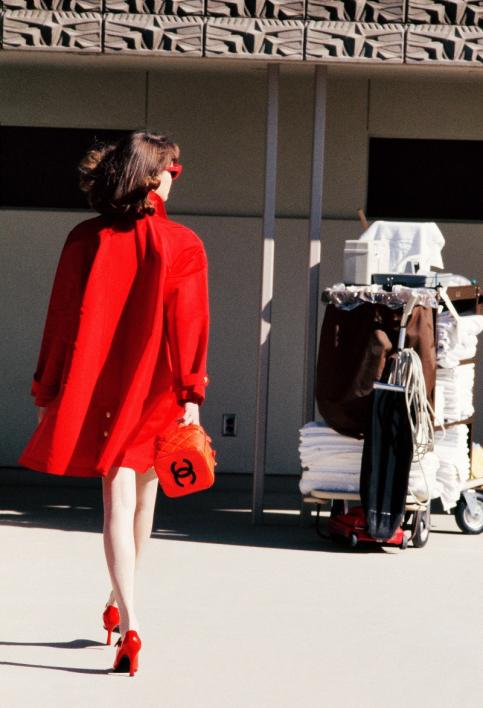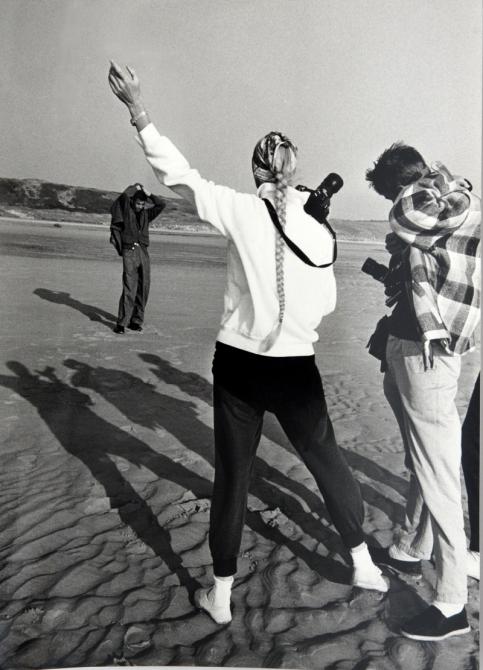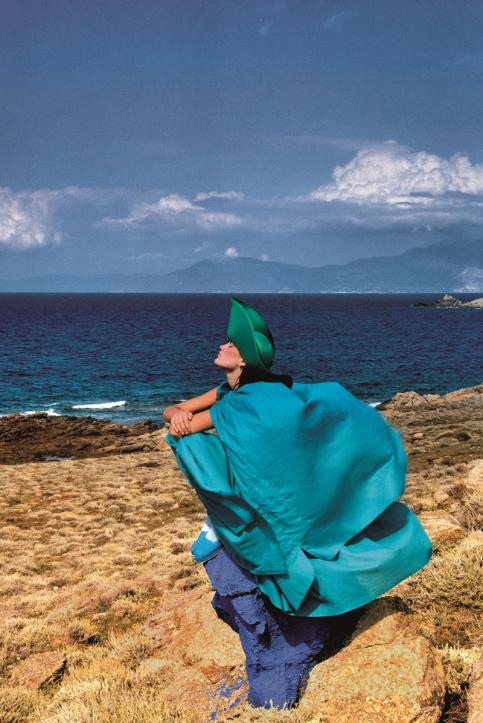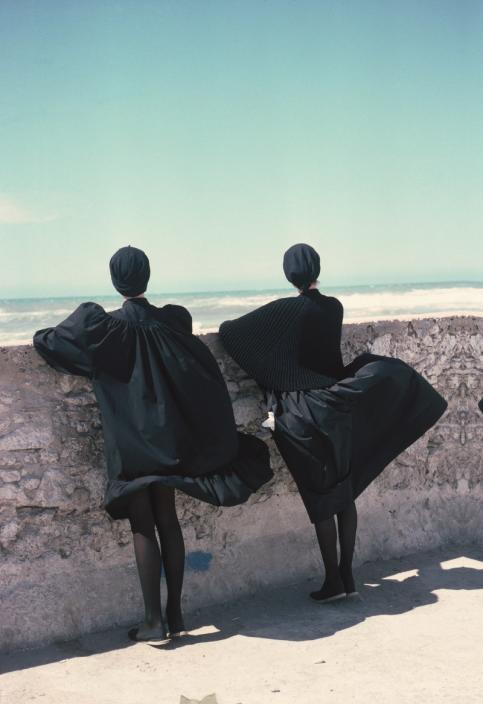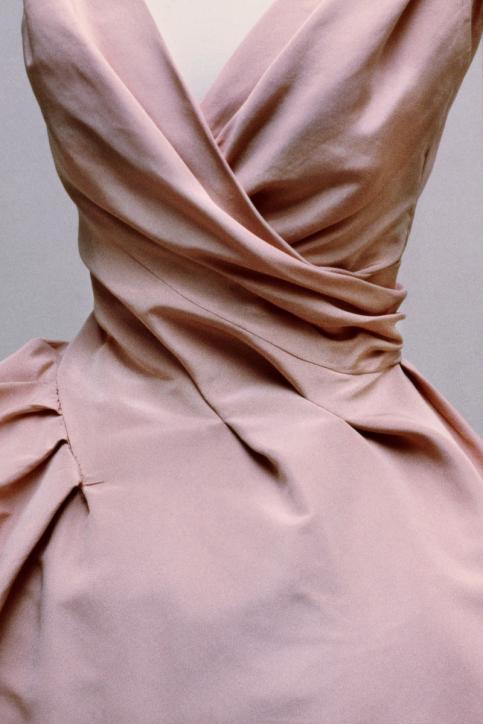She even charmed the dromedaries
(Miguel Medina, photographer)
When Elle magazine published a group portrait of its photographers taken by Peter Knapp in 1966, it only became apparent that one of the central figures was in fact a woman photographer, the young Sacha van Dorssen, when she removed her hat in the second photo. In a profession that produces a huge amount of extremely varied work, Sacha was to become a member of the small circle of fashion photographers whose work is today considered canon.
Sacha (born Sacha van Dorssen in Rotterdam, Holland in 1940) has made her mark as a singular fashion photographer with ineffable simplicity. Her work is instantly identifiable and she has worked for the most prestigious magazines on the planet as well as on big advertising jobs for Yves Saint-Laurent, Louis Vuitton, Dim, etc. There is no need for a signature, we all have examples of her work imprinted on our brains without needing proof.
Over the course of her career, she has worked for a wide range of fashion magazines including Elle, The Sunday Times Magazine, Stern, Vogue UK, Avenue, Le Jardin des Modes, Lui, Vogue Homme, Harper’s Bazaar Italia, GQ, Bloom and, most of all, Marie Claire
where Sacha published work in both the magazine and its offshoots more or less continuously from 1977 to 1999. All of these magazines showed their faith in the young Dutch photographer who, almost immediately on her arrival in France in 1964, was hired by the then creative director of Elle Magazine,
Peter Knapp, to do her very first reportage.
Sacha’s photographic library is made up of hundreds of thousands of slides, all carefully filed by date in little yellow boxes, along with all the publications, where we can see she has almost exclusively worked only in fashion. In fact, this exhibition could easily have just been made up of magazine covers and double pages, she shot so many of them. This collection of slides provided an unlimited source of raw material that Sacha and the magazines delved into to find the “good shots” for publication. In fashion after all, the finished product is always the magazine, where the photographs are carefully laid out and captioned.
Indeed, fashion photography really only exists through magazines and no one represented the complex chain of fashion imagery better than Sacha. When we read or listen to what Sacha has to say on the subject, the expression we hear over and over again is “teamwork”. Each photo shoot then and now, typically involves input from magazine editors, one or more assistants for logistics and lighting, models, hairdressers and make-up artists, so really, before the photographer gets to do their thing, they have to wait until everyone else is ready !
Over the years, Sacha’s assistants carefully documented each trip for various magazines, writing the technical film development specs on polaroids taken for reference. Sacha then collected all of this information in notebooks: shoot location (country, city) where the team stayed if the shoot went over one day, the names of those present, the models’ names, as well as all hotel and restaurant bills. This real-time cataloguing system today provides a fascinating insight into the way these photographs were produced and the very collective nature of the enterprise.
Sacha is often described as a demanding photographer who works slowly. She readily admits this herself: “I admit that people often say I work slowly, but when the model shows up on the shoot, all made-up and ready, it takes a while for that “made-up” aspect to wear off so that I can access something real or natural. In fact, I am not unlike a turkey farmer in Brittany, “if you want a quality product, then you’ll have to wait.”
[1]
For fifty years, magazines and brands continued to hire her for her high standards that produced such amazing results.
The quality of her framing (much to the chagrin of creative directors, her photographs are impossible to crop for the most part), her attention to detail, feeling for colour, lighting skills and the natural feel of her impeccably constructed shots, made Sacha a must-hire for magazines and brands. Here also, once the photos are taken, the work becomes team work again: fashion editors, creative directors, editors in chief… Sacha often speaks of the shared joy she experienced, and it is true that the final result is always light and full of delight.
Sacha represents a certain idea of womanhood, manhood and fashion over the span of a half century. While she did work for a wide range of fashion magazines, her name remains associated with Marie Claire and its offshoots (Marie Claire bis and Marie Claire beautés). Magazines like Elle, Vogue and Stern each have their own personality and after its relaunch by Jean Prouvost in 1954 Marie Claire developed a very strong identity. A follow-on from the original Marie Claire founded in 1937 by Jean Prouvost and Marcelle Auclair, the new Marie Claire claimed to be “a luxury magazine for everyone”, that associated fashion (both ready-to-wear and haute-couture) with life advice, film reviews, travel articles, while also including in-depth pieces on society.
In 1937, the models on Marie Claire covers were always smiling, from 1954 the style shifted to more reportage-like photographs showing models in everyday situations. As editors and society changed, so did Marie Claire, but this visual identity remained. This became Sacha’s superpower, and her capacity to capture what was “natural” or “real” was very much sought after by the magazine as it came into its eighties’ heyday with Evelyne Prouvost-Berry replacing her grandfather at the helm in 1976, ably seconded by Claude Brouet.
Models never seem like they are posing in Sacha’s work. It often feels like they have been caught in a private moment, that they are free, making us forget that there is a photographer present. Furthermore, the surrounding landscape plays an essential role. Sacha subtly combines models and backdrops, using natural light, an option she has always preferred over the studio. Peter Knapp has said of her work that she does not create silhouettes, that what surrounds the model’s silhouette does not contrast with the subject. The resulting photographs are soft, atmospheric creations where the clothes are not necessarily central, but are essential to the whole and, as such, become eminently desirable.
Sacha loved to record what was going on around the team on their advertising and fashion trips, bringing her sharp eye to bear on unexpected details to create perfect compositions. This is doubtless why Sacha was hired as the photographer for landmark books published on Mariano Fortuny
[2]
and Christian Dior
[3]
by Éditions du Regard. The first book published by Éditions du Regard, dedicated to Fortuny, is a masterclass in Sacha’s talent for capturing a particular ambience (in this case, the unique atmosphere in the Palazzo Fortuny that has remained practically untouched since 1965), tirelessly scouring the palazzo, focussing on details. José Alvarez said of her work “for Sacha, nothing is insignificant”
[4]
even though in this case, she had to adapt to the palazzo’s very specific indoor light, away from the sun and the outdoors she often preferred. For the Dior book, the requirements were different, and her subtle compositions blended beautifully with the archive material used in the book.
Since 1964, Sacha has built a singular body of work in fashion, advertising and reportage, founded on light, high standards and sincerity.
Sylvain Besson
__
Curated by :
Sacha
Sylvain Besson, musée Nicéphore Niépce
Graphic Design :
Le Petit Didier
Nicolas Pleutret
The museum would like to thank all those who made this exhibition possible :
Gabriel Bauret
Françoise Bornstein
Peter Knapp
La société des Amis du musée Nicéphore Niépce
Dingeman Kuilman
Stedelijk Museum team Breda
Beja Tjeerdsma
Marieke Wiegel
Friso Wijnen
[1] Coups de cœur et déclenchements in Sacha, Photographe de Mode , Gabriel Bauret, Éditions du Chêne, Paris, 2011
[2] Anne Marie Deschodt, Mario Fortuny : un magicien de Venise (1871-1949), Éditions du Regard, 1979
[3] Françoise Giroud, Dior , Éditions du Regard, 1987
[4] Gabriel Bauret, Sacha, Photographe de Mode , Éditions du Chêne, Paris, 2011


